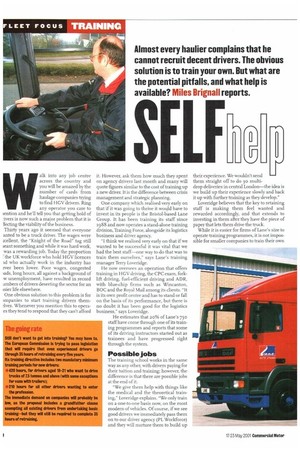lAr alk into any job centre across the country and
Page 30

Page 31

If you've noticed an error in this article please click here to report it so we can fix it.
you will be amazed by the number of cards from haulage companies trying to find HGV drivers. Ring any operator you care to Lention and he'll tell you that getting hold of ivers is now such a major problem that it is fecting the viability of the business.
Thirty years ago it seemed that everyone anted to be a truck driver. The wages were Ecellent, the "Knight of the Road" tag still Leant something and while it was hard work, was a rewarding job. Today the proportion the UK workforce who hold HGV licences Id who actually work in the industry has ever been lower. Poor wages, congested 'ads, long hours, all against a background of w unemployment, have resulted in record Limbers of drivers deserting the sector for an Lsier life elsewhere.
One obvious solution to this problem is for impanies to start training drivers them!Ives. Whenever you mention this to operaTs they tend to respond that they can't afford it. However, ask them how much they spent on agency drivers last month and many will quote figures similar to the cost of training up a new driver. It is the difference between crisis management and strategic planning.
One company which realised very early on that if it was going to thrive it would have to invest in its people is the Bristol-based Lane Group. It has been training its staff since 1988 and now operates a stand-alone training division, Training Force, alongside its logistics business and driver agency "I think we realised very early on that if we wanted to be successful it was vital that we had the best staff—one way to do that was to train them ourselves," says Lane's training manager Terry Loveridge.
He now oversees an operation that offers training in HGV driving, the CPC exam, forklift driving, fuel-efficient driving and ADR, with blue-chip firms such as Wincanton, BOC and the Royal Mail among its clients. "It is its own profit centre and has to stand or fall on the basis of its performance, but there is no doubt it has been good for the logistics business," says Loveridge.
He estimates that 20% of Lane's 750 staff have come through one of its training programmes and reports that some of its driving instructors started out as trainees and have progressed right through the system.
Possible jobs
The training school works in the same way as any other, with drivers paying for their tuition and training; however, the difference is that there are possible jobs at the end of it.
"We give them help with things like the medical and the theoretical training," Loveridge explains. "We only train on a one-to-one basis now, on the most modem of vehicles. Of course, if we see good drivers we immediately pass them on to our driver agency (PL Workforce) and they will nurture them to build up their experience. We wouldn't send them straight off to do 30 multidrop deliveries in central London—the idea is we build up their experience slowly and back it up with further training as they develop."
Loveridge believes that the key to retaining staff is making them feel wanted and rewarded accordingly, and that extends to investing in them after they have the piece of paper that lets them drive the truck.
While it is easier for firms of Lane's size to operate training programmes, it is not impossible for smaller companies to train their own drivers, and there is government help available. The first point of contact for operators thinking of going down this route is the Road Haulage Distribution Training Council (RH DTC). This organisation is jointly funded by the Road Haulage and Freight Transport Associations along with the removals association, BAR, and it has just launched a major new initiative to train 2o,000 young drivers over the next five years.
RH DTC chief executive Ian Hetherington says the days of a haulier going out onto the open market and finding trained and experienced staff have long gone, and the industry has got to wake up to this fact and take a more proactive approach. However, he also sounds a word of caution: "Hauliers who think the government will pay all the costs for them to train up their warehousemen are not being realistic. There are certain criteria that you have to meet to get grants and they generally split into those prepared to offer young people apprentice-type training, and those who are prepared to take someone off the unemployment register."
Anyone going down the latter path can apply for New Deal funding, which allows the haulier to draw £750 towards training costs and offers a subsidy of £60 per week for six months. The candidates have to demonstrate that they already have some skills appropriate to their career choice—a car driving licence is not sufficient on its own, for example.
For those going down the apprenticeship route the money on offer is more generous, but it is also more complicated and time-consuming to administer. Up to £5,000 is avail
able for training costs, and if you combine it with the young driver programme you can even train is-yearolds to drive trucks, although they have to take further training after they have passed their tests. Because it is so com plicated, hauliers should talk directly to RH DTC to get a better idea of what grants they may be eligible for.
Two years
The easiest way to train a driver is simply to stump up the £1,500 or so an HGV course costs today. You can put a clause in his contract to say that he will have to repay the cost of the training if he leaves before a "reasonable" period has passed; say two years.
However, you have to consider how you would get your money back if your newly trained driver departed—the chances are you would never see the cash again. Hetherington and Loveridge agree that the most important factor in retaining staff is pay and conditions: "There's no point in paying for training and then offering poor wages as you'll just lose them," says Hetherington.
Loveridge maintains that the secret of retaining people is to show your commitmt by continuing to train them. "If they are bei taught new things all the time and their exi rience is widening they will be much mc reluctant to leave," he says. "Offer them future and chances are they will stay.
The Working Time Directive's introducti is only going to exacerbate the driver shorta and put further pressure on hauliers to sti training drivers of their own. So next time y sign off the agency bills, stop and think whE else you might be putting the money...
Contact: The RHIITC on 01908 313360 or www.rhdtc.co.uk.


































































































